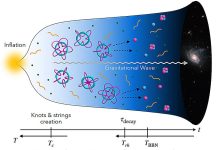
Astronomers have, for the first time, mapped a mysterious form of matter in our galaxy that had remained invisible until now.
Using the U.S. National Science Foundation’s Green Bank Telescope (GBT), an international research team has revealed vast clouds of “CO-dark” molecular gas—hidden material that plays a key role in forming new stars.
The discovery focuses on Cygnus X, one of the Milky Way’s most active star-forming regions.
For decades, scientists have known that stars are born inside enormous clouds of molecular hydrogen.
However, this gas is nearly invisible to telescopes because it doesn’t emit detectable light.
To locate it, astronomers usually trace another molecule, carbon monoxide (CO), which glows brightly and acts as a stand-in for hydrogen. But this method misses large amounts of gas that don’t contain CO—what researchers call “CO-dark molecular gas.”
Now, scientists have finally mapped this hidden material across an area of sky 100 times larger than the full Moon.
They did so by detecting faint radio signals from carbon atoms, known as Carbon Radio Recombination Lines (CRRLs).
These signals allowed them to visualize where the invisible gas lies within Cygnus X, a region about 5,000 light-years from Earth teeming with newborn stars.
“It’s like turning on the lights in a dark room and suddenly seeing all the structures we never knew existed,” said Kimberly Emig, lead author of the study and an astronomer with the National Radio Astronomy Observatory.
The new map reveals an intricate web of arcs, ridges, and filaments of dark gas winding through Cygnus X. These patterns show where star-forming material gathers before it becomes visible as dense molecular clouds. The study also found that this gas isn’t static—it moves and flows rapidly, much faster than previously thought. Such turbulence could determine how quickly new stars emerge.
The researchers also discovered that the brightness of the carbon signals is linked to intense starlight in the region, showing how radiation affects the recycling of gas in the galaxy.
“By making the invisible visible, we can finally track how simple atoms evolve into complex molecules that will one day form stars, planets, and perhaps even life,” said Emig.
The Green Bank Telescope is now leading more large-scale surveys to study this hidden material in other parts of the Milky Way. These findings will help scientists better understand how galaxies, including our own, build the massive clouds that give birth to stars.



